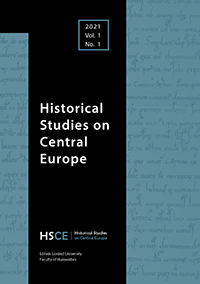Published 30-04-2021
Keywords
- monastic orders,
- Benedictines,
- monastic reform,
- centralized orders,
- Cistercians
- Praemonstratensians,
- choir structure,
- right of sepulture,
- cloisters with regular shape ...More
How to Cite
Copyright (c) 2021 Ernő Marosi

This work is licensed under a Creative Commons Attribution-NonCommercial 4.0 International License.
Abstract
The hypothetical interpretation of the beginnings of monastic architecture in Hungary in the eleventh century as corresponding to the Italian origin of the clergy cannot be proved, and the beginning of the dominating role of a three-apsidal, axially organized basilica in Hungary cannot be traced earlier than the last quarter of the eleventh century.
The dominance of the type, which has been considered in Hungarian art history since the nineteenth century as a “national” building type, can be dated as of the last quarter of the eleventh century. It is not only the problem of monastic architecture, because the same typology—in other dimensions—is also characteristic of other church buildings—cathedrals and provostry churches.
However, it is apparent that both in the case of monasteries and in other genres of church buildings, the Hungarian solutions are minimal and less complicated. There is an important written source concerning the value of the patronage of church buildings. The so called Estimationes communes iuxta consuetudinem regni (i.e. common estimations) go back to Romanesque times and they were still accepted in 1516 by the printed edition of Decretum tripartitum by István Werbőczy. The classification of ecclesiastic property was governed by two criteria: the value of the building and the possession of the right of sepulture.
The architectural heritage of the Cistercians appears as a rather uniform stylistic phenomenon. This uniformity was interpreted in the art historical literature as a contribution by the order supposedly having an own building organization. But the hypothesis that the workers, the conversi of the order were among the other craftsmen and builders of churches and monasteries of the order has been revealed as a legendary interpretation of art history.
The most active period of the Hungarian Cistercians began with the privileges given by King Béla III to the Order and with the foundation of three abbeys in the 1180s. The very rational and well-organized building activity of the Cistercians and also the effective control coming from the top of their centralized organization has been presumably considered as unusual by contemporary observers.
To prevent the excessive influence of secular people and to improve the education of the monks, the centralized organization was proposed for the Benedictines too. This reform was initiated by popes of the time about 1200, Innocent III and also Honorius III. It seems that the necessary reform as well as the solution of the problems by adopting the experience of the Cistercians influenced the spread of the regular monastery building under the evident intention of imitation. Quadratic interior courts framed by open galleries and surrounded by the most important common rooms, including the chapterhouse and refectory of the monastery, appear evidently from about 1220 in Hungarian Benedictine architecture.
The Praemonstratensians, a reform order, was a nearly contemporary parallel to the Cistercians. In the twelfth century and also at the beginning of the thirteenth they were in fact in a straight contact with the Cistercians, who exercised a kind of control over the order, whose rules were not derived from the Benedictine rules but were based on the rules of St. Augustine. Mainly the centralized organization of the order could correspond to the Cistercian model. The main difference between these reform orders concerned their patronage. While the Cistercians in Hungary were mostly under royal patronage (mainly after the visit of a delegation of Cîteaux to the Court of Béla III in 1183), the Praemonstensian constructions were mainly foundations by private patrons.
It seems that contrary to partly surviving hypotheses and forgeries in old art historical literature, no royal court and also no monastic order was practically involved in architecture or building praxis, including schools of architecture. Their relationship was different, corresponding to their liturgy and to the representation of their self-image.

